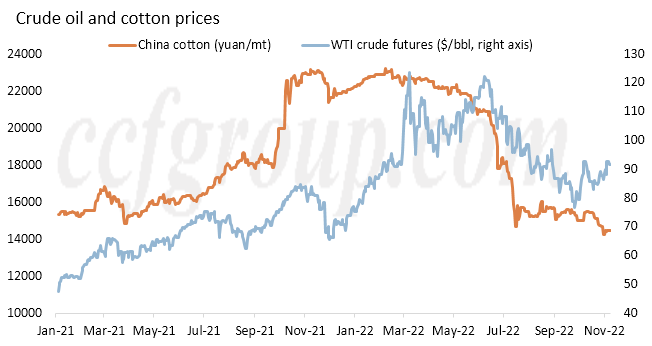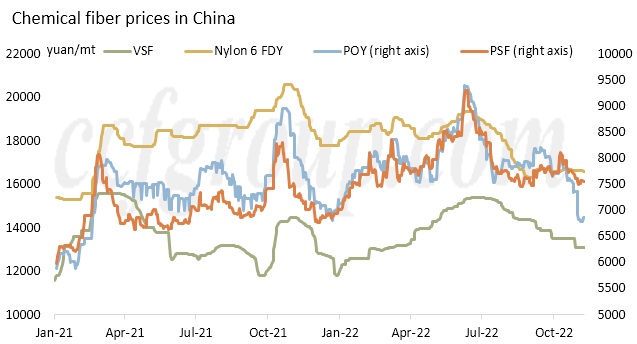China chemical fiber industry operation review for 2022
China chemical fiber industry has experienced constant changes year to date in 2022. In the first half year, feedstock price hovered high, and the affordability of feedstock for chemical fiber producers drew much attention. In the latter half year, commodity futures slumped amid interest rate hikes globally. With increased volatility in prices as well as the resurge of pandemic in China, companies are faced with immerse challenges.
Chemical fiber market review
In the first quarter of 2022, companies were under strains with high plant operating rates. In the beginning of 2022, chemical fiber price continued the strength, however, product inventory kept increasing with plant operating rate on the high side. In late Feb, international crude oil prices spiked as Russia-Ukraine conflict broke out, and thus higher cost of raw materials brought increasing risks to chemical fiber industry. Afterwards, the pandemic resurged and spread in some regions of China, leading to logistics restrictions due to measures to combat the pandemic. With wholesale and retail sales under pressure, end-use plant cutting operating rates in mid and late Mar amid slowdown of product circulation.
In the second quarter, chemical fiber production dropped on year due to the pandemic as well as weak demand. In Apr, plant operations took a hit by the pandemic, with operating rates of several products dropping sharply and even refreshing this year’s low. After the Tomb-Sweeping holiday in early Apr, some regions were locked down with restricted logistics due to the pandemic. Chemical fiber’s downstream plants were shut for maintenance intensively. In May and Jun, market sentiment recovered to some extent with the pandemic impact winding down. However, demand had yet to increase, slowing down the recovery of chemical fiber production.
In the third quarter, risk of economic downturn dealt a blow to the market. Demand for gasoline reached the peak in late Jun, but then international crude oil price extended the losing streak. Then, expectation of interest rate hike by Fed strengthened, driving up US dollar. In addition, commodity futures were dragged down by concerns about economic challenges. Crude oil price kept declining till end-Sep.
In Jun and Jul, end-use market was in slack consumption season. In the first half of Aug, heatwave and power rationing swept over China. End-use demand did not pick up until Aug and Sep. However, both chemical fiber and downstream plants faced with high inventory, and thus participants were cautious in the negotiation of prices.
In the fourth quarter, the market fluctuated and corrected amid changing environment. In early Oct, commodity futures market rebounded. Some chemical fiber producers received increasing orders. For example, orders for polyester knitted fabric increased once, leading to a backlog of orders at dyeing plants. In late Oct, some grey fabric trading markets were locked down with trading suspended due to the pandemic, and therefore orders reduced rapidly. Amid high inventory coupled with cautious expectation, end-use plant operating rate declined fast in early Nov, and some even considered to shut in advance for holiday.
From the macroeconomic standpoint, commodity futures market moved up, restrictions in China were expected to lift, and financial market sentiment improved in Oct-Nov. However, for entity enterprises, there was still pressure due to sluggish demand, and the market moved down.
Chemical fiber industry operation
The prices drifted lower with great volatility. In the first half of 2022, prices of most products hovered high, continuing the strength and getting supported by strong feedstock. In the latter half, however, with Fed’s hiking interest rate sharply, commodity market was bearish. Demand was sluggish amid economic risk, dragging down chemical fiber markets.


Y-o-y change of prices in chemical fiber chain
| WTI crude futures | POY | NFY | Cotton | VSF | PSF | Cotton yarn | Rayon yarn | Polyester yarn | |
| Early 2022 | 58% | 21% | 17% | 45% | 3% | 17% | 21% | 14% | 12% |
| Early Nov-22 | 5% | -20% | -19% | -38% | -10% | 0% | -23% | -11% | -11% |
It can be seen from the figure that both chemical fiber and cotton textile product prices, from raw material, fiber to yarn, were high in the beginning of 2022, increasing from the same period of last year. As of early Nov, however, except for crude oil, prices of other products were lower compared to the level in the same period of last year.
The markets were bolstered by high cost earlier, but then, prices declined amid weak demand. It would be tougher for chemical fiber industry with the increasing price volatility.
The inventory was in rising cycle. Chemical fiber industry was under selling pressure in 2022, leading to continuous rise in product inventory. Compared to the level in the beginning of the year, the inventory has rebounded obviously.
Change of inventory in chemical fiber chain
| Day | POY | NFY | PSF | VSF | Polyester yarn | Cotton yarn | Rayon yarn | Cotton fabric | Rayon fabric |
| Early 2022 | 18 | 24 | 3 | 25 | 5 | 27 | 19 | 32 | 26 |
| Early Nov-22 | 28 | 39 | 12 | 27 | 31 | 30 | 33 | 35 | 31 |
| Change | 10 | 15 | 9 | 2 | 26 | 3 | 14 | 3 | 5 |
In fact, product inventory is showing an uptrend in recent two years, and the high inventory could become a normal state.
Under the strains from high inventory, companies had to provide discounts in the selling, and it was difficult to raise the prices during the negotiation of orders.
Plant operating rate continued dropping in 2022. In the first three quarters of 2021, plant operating rate hovered high, and did not declined heavily until Sep when dual controls on energy consumption and intensity were implemented. In 2022, dragged down by weak demand, plant operating rate started dropping in the second quarter, and it was difficult to rebound to previous highs.
The year to date average operating rate has declined compared to the same period of last year. Most plants reined in operating rate under high inventory and weak demand.
Change of plant operating rate in chemical fiber chain
| % | POY | NFY | PSF | VSF | Polyester yarn | Cotton yarn | Rayon yarn | Cotton fabric | Rayon fabric |
| 2021 average | 83 | 79 | 88 | 74 | 61 | 60 | 55 | 55 | 52 |
| 2022 YTD average | 75 | 76 | 77 | 73 | 56 | 48 | 48 | 46 | 48 |
| Change | -8 | -3 | -11 | -1 | -5 | -12 | -7 | -9 | -4 |
In a conclusion, throughout the year of 2022, product prices were more volatile, inventory stayed high while plant operating rate fell, indicating reduced prosperity of the industry.
- Top keywords
- Cotton Price
- Cotton Futures Price
- Cotton Futures
- CZCE
- PTA Futures Price
- Chemical Fiber
- Polyester Prices
- Wool price
- PTA Futures
- Shengze Silk
- China
- Yarn Price
- price
- China Textile City
- Fibre Price
- Benzene Price
- Cotton
- Index
- Cotton Index
- PTA
- fabric price
- NYMEX
- Top 10
- textile industry
- Spot Cotton
- Cotton Yarn
- Polyester Price
- Futures
- PTA Price
- cotton yarn price

